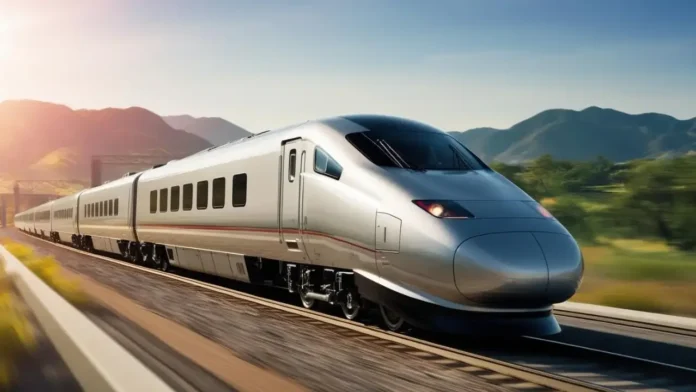India is gearing up for a major leap in transportation with the proposed Mumbai–Hyderabad bullet train corridor. This high-speed rail project aims to connect two of the country’s most important cities in just three hours, drastically cutting down travel time and boosting economic and social ties between Maharashtra and Telangana.
The Ambitious Goal: Fast Travel at 350 km/h
The Mumbai–Hyderabad bullet train will cover approximately 767 kilometers, linking Mumbai, Pune, and Hyderabad through 11 planned stations. The train is expected to run at a maximum speed of 350 km/h, with an average speed around 250–320 km/h, reducing the current travel time from over 14 hours by conventional trains to just three hours.
Planned Route and Stations
The corridor will feature a combination of elevated tracks, tunnels, and surface-level sections to navigate urban and rural landscapes efficiently. The key stations along the route are expected to include:
- Bandra Kurla Complex (Mumbai)
- Thane
- Navi Mumbai
- Lonavala
- Pune
- Solapur
- Gulbarga
- Zaheerabad
- Vikarabad
- Secunderabad
- Hyderabad
This route is designed to maximize connectivity and serve major population centers and industrial zones, fostering regional development.
Cutting-Edge Technology and Safety Features
The bullet train will incorporate the latest rail technologies to ensure safety, efficiency, and reliability:
- Digital Signalling Systems: For precise train control and scheduling.
- Electric Traction with 25 kV AC Overhead Lines: Providing consistent and powerful energy supply.
- Earthquake Detection Systems: Automatically halting trains during seismic events to prevent accidents.
Each train will be designed to carry around 750 passengers comfortably, with modern interiors and amenities rivaling air travel standards.
Economic and Social Benefits
The introduction of this high-speed rail line is expected to:
- Significantly enhance business and tourism between Mumbai, Pune, and Hyderabad.
- Stimulate economic growth and urban development along the corridor.
- Offer an eco-friendly alternative to air and road travel, reducing carbon emissions and traffic congestion.
Additionally, the project will generate employment opportunities during construction and operation phases, contributing to skill development in India’s rail and engineering sectors.
Pricing and Accessibility
While exact ticket prices are yet to be finalized, early estimates suggest fares will be roughly 1.5 times the cost of a first-class AC train ticket on existing services. This pricing aims to balance affordability with the premium service offered, attracting business travelers, tourists, and daily commuters.
Current Status and Timeline
The Mumbai–Hyderabad bullet train project is in the detailed planning and survey phase. Key developments include:
- Completion of feasibility studies and environmental impact assessments.
- Finalization of route alignment and station locations.
- Expected start of construction after the Mumbai–Ahmedabad bullet train project progresses further.
Experts anticipate that the Mumbai–Hyderabad corridor could become operational within 10 to 13 years, considering the scale and complexity of the infrastructure involved.
Integration with India’s Expanding High-Speed Rail Network
This project is part of India’s broader vision to develop a nationwide high-speed rail network connecting major cities such as Mumbai, Hyderabad, Bengaluru, Chennai, and Ahmedabad. The Mumbai–Hyderabad line will complement other corridors, facilitating faster movement of people and goods and driving economic growth.
Challenges Ahead
Despite its promising outlook, the project faces several challenges:
- Land Acquisition: Procuring land in densely populated and industrial areas can be complex and time-consuming.
- Funding and Technology: Securing adequate investment and advanced technology transfer is critical.
- Environmental Concerns: Ensuring that construction minimizes ecological impact, especially in sensitive zones.
The government and stakeholders are working to address these issues through careful planning, stakeholder engagement, and adopting best practices from global high-speed rail projects.
Conclusion
The Mumbai–Hyderabad bullet train promises to revolutionize travel between two of India’s key economic hubs by reducing journey times to just three hours at speeds up to 350 km/h. With cutting-edge technology, enhanced safety, and significant economic benefits, this project marks a transformative step in India’s transportation landscape. As the nation moves forward with this ambitious plan, travelers can look forward to a fast, comfortable, and efficient new way to connect Mumbai and Hyderabad.
SEO Summary:
India’s Mumbai–Hyderabad bullet train will cut travel time to 3 hours, running at speeds up to 350 km/h. Featuring 11 stations and advanced safety systems, this high-speed corridor will boost connectivity and economic growth between Maharashtra and Telangana. Stay informed on India’s high-speed rail progress and future travel options.
If you want, I can also help you with images, infographics, or social media posts related to this topic!



